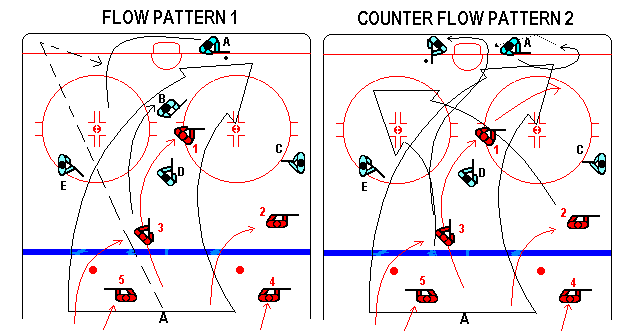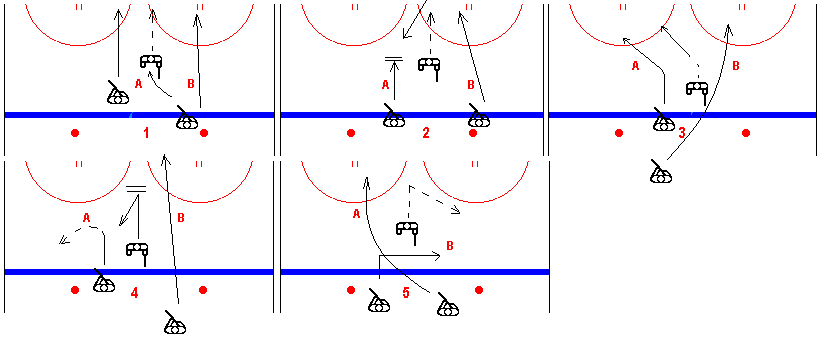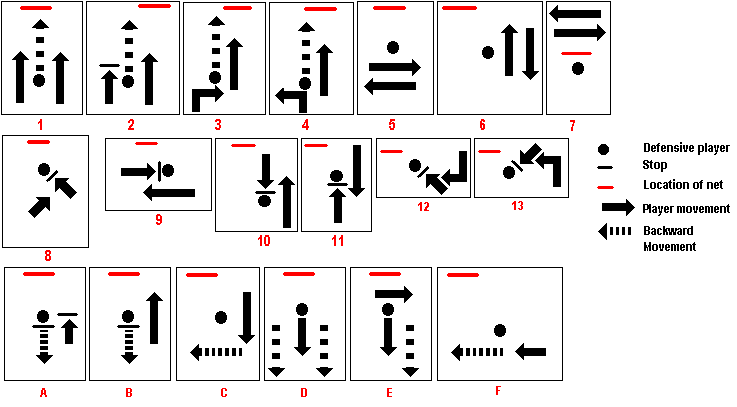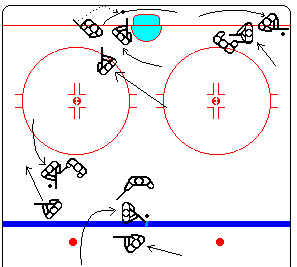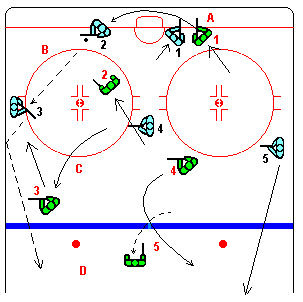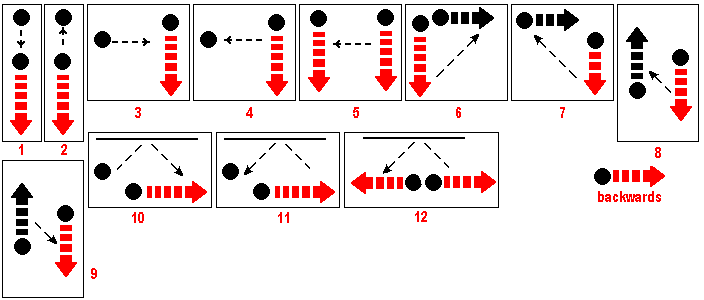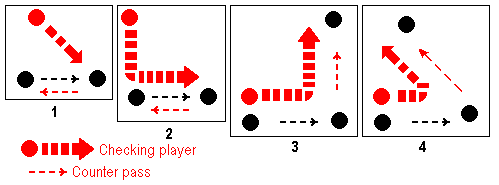Game THEORY CONCEPTS - FLOW |
||
|
As previously mentioned, hockey is a game of speed and finite (limited) space. When one begins to analyze the fact that a player at an elite level (bantam AAA to professional) will move between 18 - 26 feet per second in a straight line or an elite player between Bantam AAA and Professional will accelerate 30 feet anywhere from 1.4 to 1.7 seconds, thinking and reaction speed become critical.
How much information about what "WE SEE" or observer during game play do we actually understand or as the ad goes, " there is a lot to be said about clarity". Most hockey player's and coach's for that matter, operate in a pattern recognition environment. Regroup drills, breakout drills, etc are all pattern based. What I mean by pattern is that there is a predetermined pattern of puck and player movement. While the game has recognizable patterns within its framework (breakouts, power-play, etc), the puck or even players do not necessarily react the way we expect. Much of the game then becomes "Read and Reaction" based.
In order to provide some form of clarity to all of this confusion, we must comprehend "FLOW". Flow is a term that describes the movement of players interacting and reacting to movement of the puck. In order to adequately analyze FLOW, we need to understand its effect on time and space. Basically, FLOW MOVEMENT has 3 distinct layers, or depth as well as 3 distinct lanes, or width. My studies have shown that each layer or lane reacts each second. In other words, in a 2-1-2 fore-checking system, the first layer reacts in the first second (2), the second layer in the second second (1) and the third layer reacts in the third second (2 - or defensemen). How fast one team moves the puck laterally (D to D for example) or vertically (Def to Wing) will set up what type of option is available upon reception. The slower the puck movement (stating the obvious here) the higher the checking pressure, the less time to create or identify options. Shown below in FLOW PATTERN 1 is a basic example of checking pressures relative to puck movement or, game "FLOW". As a result of the initial play (dump-in), the puck movement is left to right and the opposition players have to adjust accordingly with the most obvious first adjustment being the primary forechecker (1st man). Reading off the puck carrier and the primary, the secondary checkers move left to right also in anticipation of a play up the wall. As a result of this DEFENSIVE FLOW, options open up as a result of FLOW PRESSURE. This is providing of course that both defenseman read and react accordingly. In most cases, coaches encourage the D-man to fire the puck off the glass and out of the zone. THIS IS WRONG!!!!. Visual training, communication and reactionary skills MUST be developed.
As we can see in the diargrams below, space and options are created to the weak side for offense play selections as a result of DEFENSIVE FLOW pressure. What now becomes important is what is termed "CRITICAL DISTANCE". Critical distance is the gap between the primary/secondary checkers and the puck-carrier and intended receivers. Puck speed (passing velocity) and player speed (not excluding skill) now become critical factors as well.
(A) is origin of play (dump-in) with 1-2-2 forecheck. Primary (1st) player reacts to puck carrier with secondary and back-side checker moving in anticipation.
NOTE: Offensive success or failure (breakout in this situation) is directly related to either of the following principles: 1- speed of puck movement (fastest possible variable) 2 - puck direction (with or against flow) or 3 - player speed (puck carrier or support player/s) 4 - player movement (puck carrier or support player/s - either with or against flow).
Not meaning to confuse you by jumping zones here, but I would like to progress into offensive theories or OFFENSIVE FLOW theory starting with on one on one situations. These situations are most often recognized as Offensive Blueline confrontations. We can look at these confrontations as being the leading edge of OFFENSIVE FLOW or the initial beginning of O.F.
I will start with offensive zone out-side lane penetration (man on man options at offensive blue-line). The following examples will demonstrate how a puck carrier creates flow variations on the leading edge as a consequence of his decision making. These decisions are based on VISUAL observations both frontal (directly in front of the puck carrier), peripheal (to either side of the puck carrier) and to the back side of the play. All plays (with the exception of man advantage situations - power play, penalty kill) begin off of a one on one read.
There are 5 basic out-side lane variations off of which there are alternate options (changing speeds, counter cuts, etc) but for simplicity sake we will identify them as the following:
1 -wide drive, 2 - Drive and stop, 3 - Delay 4 - Fore-ward to backward pivot (face open ice), and 5 - mid-lane cut.
When analyzing mid-lane options, they are as follows:
1- Seam drive (speed), 2 - Seam stop (possible shot), 3 - Corner angle drive, 4 - Seam turn back, 5 - Seam lateral shift.
Option selection is determined by several factors; speed, space and ability (both offensive and defensive player/s). In order to involve secondary and back side support players successfully, all involved must READ the same variables. Offensive options when dealing with one on one situations are relative to gap (space between puck carrier and defensive player) and ability of players (skill intelligence, anticipation, tactical intelligence, etc). When coordinating attack with a support player, the objective is to create a better option either through more space, a better lane or by generating more time to select options. We want defensive players making decisions, having to chose between one of two possible options as shown below. As well, we want to be able to perform these variations at the highest speed possible to further limit successful defensive decisions.
1 - outside lane drive and drop/back pass, 2 - outside lane stop and support drive, 3/4 - outside lane delay / pivot, support drive, and 5 - mid-lane cut and outside drive support.
Obviously, anytime the above situations arise, a mistake defensively has been made elsewhere on the ice. While not perhaps depicted EXACTLY as they would look in a game, visually we can still get the picture, and of course, whether or not you would consider some of the above options would become valid as well. However, there are situations where such situations arise (perhaps penalty kill, late in a shift, late in the game, etc). We can start to identify are specific player movements (left to right, cut backs, etc) relative to puck carrying and support that, while depicted in the above diagrams in the offensive zone, could happen anywhere on the ice.
The following diagrams represent specific two on one player interactions and are to demonstrate player movement (skating) options in two on one situations.
Forward Variables 1 - Forward speed / speed versus backward speed 2 - Stop/speed 3 - Cut/speed 4 - Reverse cut / speed 5 - Crossing / Horizontal lane above the net 6 - Crossing / Vertical side of net 7 - Crossing / Back of net 8 - Diagonal Pick / Cross 9 - Horizontal Pick / Cross 10 - Vertical Pick Low / Cross 11 - Vertical Pick High / Cross 12 - Diagonal Pick High / Cut 13 - Diagonal Pick Low / Cut
Backward Variables A - Forward stop / Backward open B - Backward draw / Forward open C - Forward draw / Backward open D - Backward draw E - Backward draw / forward cross F - Forward / Backward Cross
Looking that the above drawing we can see that these options can be broken down into even more basic forward skating rules:
1 - Speed, 2 - Speed / Stop, 3 - Speed / Cut, 4 - Cross / Cross, 5 - Pick / Cross, 6 - Pick / Cut
As shown above, backward skating variables can included as in above situations where players pivot backwards to face puck/play as as in this diagram where player initiate play through backward movement.
We can basically design all two on one options off of these basic variables. The following diagram takes Crosses as an example and demonstrates several situations where they could be used:
We can create many play options utilizing above variables and we will do so later. What we must remember is that as we isolate one 2- 1 variable successfully (depending of course where on the ice it happens) we automatically move into another 2 on 1 situation. The following diagram is to demonstrate how an offensive attack, beginning inside the defensive zone, progresses up the ice from one two on one situation to another:
Looking at the above diagram, we can see that this breakout is a succession of two on ones created by checking pressure and support. Offensive players utilize a variety of picks, skating maneuvers ; cuts, acceleration and speed, as well as a variety of passes; direct and wall/bank pass. Passing options specific to 2 on 1 situations will be covered in depth later. This diagram is broken down as follows: A - Checking primary (1) pressures def (2) and is picked or screened off by support player (1). Opposition secondary (2) pressures defense (2) who passes off to winger (3). Near side defense-man (3) pinches on read. Support center (4) breaks onto puck wide side, while wide winger (5) breaks down wide side lane. High checking forward (4) turns to pick up wide side forward. Defense-man (5) pivots and accelerates backward into neutral zone.
In essence we can break down this outlet play categorically by description using the above basic principles (no we have not covered the passing variables) and create a basic vocabulary: Pick, pass, pass, speed. "Pick" and "Speed" specifically describe skating / player to player interaction. Passing variables would be broken down as well into more specific terminology. From here on, I will use this format to breakdown 2 on 1 options. Once we have covered passing variables, each will have its one descriptive denotation. The above option would then read: Pick, Direct, Bank, Speed with "Direct" and "Bank" describing passing variables
Passing variables are as follows and depict various options available to players during game play. Each option shown here exists as an integral part of offensive success. Puck movement must be relative to player movement. .
These options depict forward skating movement. Regroup options (forward to defense, or defense to defense) would incorporate backward skating and backward to backward passing. These options will be detailed later.
1-Static to Static 2-Static to motion 3-Motion to static 4-Motion to motion (linear - parallel) 5-Motion to motion (diagonal) 6-Motion to motion (cross) 7-Motion to motion (linear - lead) 8-Static to static )bank) 9-Static to motion (bank) 10-Motion to static (bank) 11-Motion to motion (backside bank) 12-Motion to motion (lead bank) 13-Motion to motion (backside drop) 14-Motion to motion (vertical cross drop) 15-Motion to motion (horizontal linear drop) 16-Motion to motion (cross-cross drop)
The following diagrams deal specifically with backward passing (regrouping and transitory passing)
While the above options deal specifically with basic passing fundamentals, successful execution of each option plays a critical role in offensive tactics. I would like to focus primarily on the two most important passing fundamentals; pass direction, and/or passing speed. How these fundamentals are used will ULTIMATELY determine offensive success. In the diagrams shown below (using former DEFENSIVE FLOW diagram, I have provided an example to demonstrate relationship between CRITICAL DISTANCE and PASSING DIRECTION/SPEED.
To better describe this relationship we must understand the important and/or relevance of TIME! How quickly players move into position will determine efficiency or success of play. TIME! CREATION OF TIME, USE OF TIME and the creation of EXTRA TIME is the key to offensive success (and limiting TIME is the key to successful defense).
The following facts must be recognized: 1 - Move into support position as quickly as possible. 2 - ALWAYS face the play so as to get a BETTER or LONGER read off the play. 3 - MOVE THE PUCK QUICKLY to limit defensive FLOW. 4 - MOVE THE PUCK AGAINST THE FLOW WHEN EVER POSSIBLE. 5 - DO NOT TELEGRAPH PASSES (limits defensive players ability to react quickly) 6 - TAKE ADVANTAGE OF OPPONENT'S WEAKNES (slow moving players, poor reactionary players, slow thinking players, players that turn their back on the play, players that are too eager and commit early, etc). 7 - UTILIZE YOUR STRENGTHS (hard passes, quick acceleration, speed, etc) 8 - COMMUNICATE!!!!!! Keep all players on the same page if there is any chance of confusion.
While the above fundamentals deal more with one dimensional passing; player "A" to player "B", we need to analyze Defensive FLOW specific to passing to better understand how to put passes together sequentially. The following diagrams deal with puck movement as opposed to passing velocity and relate to checking pressure. Direction of pass takes advantage of a checking players inability to react quickly to puck movement and incorporates multiple passing scenarios (touch passes). Changes of direction by the defensive players that require the most effort have the greatest chance of success; stop/starts and tight turns rate highest in degree of difficulty (this is why defensive players must support each other properly to eliminate this weakness).
Efficiency of "counter" (movement of puck [offense attack] against DEFENSIVE FLOW) is dramatically increased by carrying the puck, supporting the play or by passing in such a way that defensive players are forced to over skate thus increasing the length of time that it takes to change direction. This again, increases time which maximizes players ability to select alternate options.
CODE WORDS - BE ABLE TO STATE ONE OF THE KEY PASSING FUNDAMENTALS IN THE ABOVE PARAGRAPH. (DO NOT FORGET THIS CODEWORD> FOR THE PLAYERS STUDYING THIS INFORMATION THAT I AM WORKING WITH, I WILL ASK YOU THIS QUESTION.
Copyright © 1996 by Ron Johnson. All rights reserved.
|
|
|
